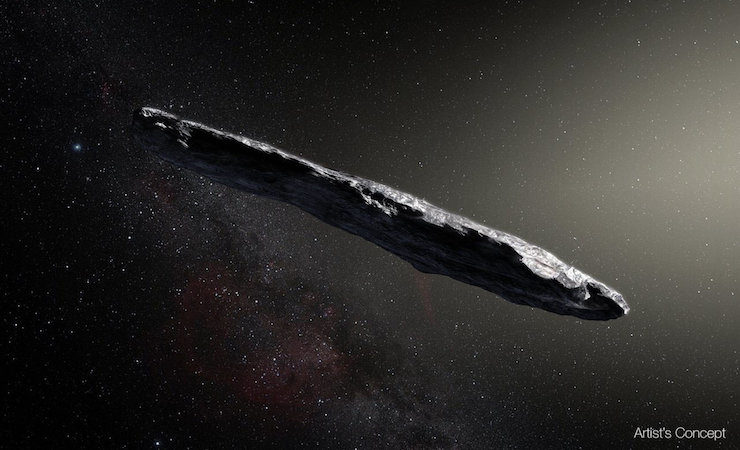Arthur C. Clarke’s 1973 Rendezvous with Rama is a classic example of how First Contact is supposed to go. In the 2130s, astronomers make a chance discovery: an interstellar object traversing the Solar System. In this future, spacecraft of various kinds swarm through the Solar System. It’s possible to divert two spacecraft (one a robot, one crewed) towards the object. The robot probe reveals that Rama is an artifact. The crew of the other vehicle get to explore Rama.
Clarke’s optimistic predictions are driven by narrative need—it wouldn’t have been much of an SF tale otherwise. “We saw something really weird but didn’t get a close look at it” is only satisfying in ghost stories, not in First Contact tales.
In the real world, First Contact may have played out very differently.
Consider ‘Oumuamua .
“Just what is ‘Oumuamua?” you may ask. I am so glad you asked. It’s the first ever verified interstellar object traversing our solar system. It was discovered in late 2017. Unlike Rama, it was only spotted over a month after its first and only perihelion. Also unlike Rama, there weren’t any space probes conveniently located where they could be diverted to take a close look. And of course, unlike Rama, we have NO nuclear-powered crewed spacecraft bopping around the Solar System, let alone one in the right place at the right time to visit ‘Oumuamua.
Earth does have an admirable collection of telescopes, including Hawai‘i’s Pan-STARRS, which first revealed ‘Oumuamua’s existence (hence the Hawaiian name). Astronomers can tell us a fair bit about ‘Oumuamua. Available evidence suggests that it’s long and thin, ten times as long as it is wide. It seems to be red in colour.
It is almost certainly extra-solar in origin. Exactly where and when it originated is less clear. Perhaps it was ejected from its originating system only a few million years ago. Perhaps it was ejected billions of year ago. None of the star systems ‘Oumuamua is thought to have traversed seem likely to be its origin.
‘Oumuamua’s path suggests non-gravitational acceleration. Its path isn’t quite what it should be if the only forces acting on it were those generated by the mass of the Sun and the planets. This isn’t the first time we’ve noticed anomalous forces acting on objects in space; the Pioneer space probes are perhaps the most famous example. What might be responsible for ‘Oumuamua’s behavior?
Shmuel Bialy and Abraham Loeb’s “Could Solar Radiation Pressure Explain ‘Oumuamua’s Peculiar Acceleration?” suggests that light pressure could be the explanation, provided ‘Oumuamua has very particular properties. Let me quote its abstract:
‘Oumuamua (1I/2017 U1) is the first object of interstellar origin observed in the Solar system.
Recently, Micheli et al. (2018) reported that ‘Oumuamua showed deviations from a Keplerian orbit at a high statistical significance.
The observed trajectory is best explained by an excess radial acceleration Δa∝r−2, where r is the distance of ‘Oumuamua from the Sun. Such an acceleration is naturally expected for comets, driven by the evaporating material. However, recent observational and theoretical studies imply that ‘Oumuamua is not an active comet. We explore the possibility that the excess acceleration results from Solar radiation pressure. The required mass-to-area ratio is m/A≈0.1 g cm−2. For a thin sheet, this requires a width of w≈0.3−0.9 mm. We find that although extremely thin, such an object would survive an interstellar travel over Galactic distances of ∼5 kpc , withstanding collisions with gas and dust-grains as well as stresses from rotation and tidal forces. We discuss the possible origins of such an object.
And what might have produced such a curious object? Let me quote again:
If radiation pressure is the accelerating force, then ‘Oumuamua represents a new class of thin interstellar material, either produced naturally in the ISM or in proto-planetary disks, or of an artificial origin.
Considering an artificial origin, one possibility is a lightsail floating in interstellar space as debris from an advanced technological equipment (Loeb 2018).
The universe is a machine designed to disappoint us before killing us—even now, Sithrak oils the spit! So ‘Oumuamua is probably not an alien light sail. But what if it is?
Either it passed through our system on purpose or it was pure happenstance. Both possibilities have interesting implications.
‘Oumuamua’s velocity is remarkably unremarkable. It takes about 12,000 years to traverse a single light-year. If its course is deliberate, then its mission planners think in much longer time scales than humans do. Judging by the suspected frequency of encounters with stars, they would have to be able to plan in terms of hundreds of thousands or millions of years.
Buy the Book


A Memory Called Empire
That is intimidating, because that suggests the sort of deliberation that could allow a civilization to explore and exploit the galaxy with slow but sturdy technology. But it’s also reassuring. By the time they get around to taking a closer look at their collected data, we could well have protected ourselves from alien domination by wiping ourselves out first.
Perhaps ‘Oumuamua is space-junk, a furled light sail hurled into deepest space through some mishap (perhaps the same one that gave it its tumbling spin). If so, it’s still evidence that at least one other civilization made its way into space. Moreover, the fact that it managed to hit a target as small as our inner solar system just at the moment we developed the technology raises an interesting question: was this merely the sort of extremely unlikely coincidence one should expect in a universe as old and large as ours? Or is the Milky Way awash in enough alien space junk that we can expect to discover discarded light sails with some frequency?
Either way, I am not sure about the implications for the Great Filter (the hypothetical process or processes that explain our lack of visitors). Having an alien artifact tumble through the system almost as soon as we were able to spot it might suggest there is no Great Filter, that we haven’t noticed aliens not because they’re absent, but because we’ve been going about it in the wrong way. Or perhaps the Great Filter kicks in after technological species reach the point where their relics litter the Milky Way.
These are all questions we have the ability to answer, given time. All we need do keep funding astronomers, and keep watching the skies.
In the words of Wikipedia editor TexasAndroid, prolific book reviewer and perennial Darwin Award nominee James Davis Nicoll is of “questionable notability.” His work has appeared in Publishers Weekly and Romantic Times as well as on his own websites, James Nicoll Reviews and Young People Read Old SFF (where he is assisted by editor Karen Lofstrom and web person Adrienne L. Travis). He is surprisingly flammable.










